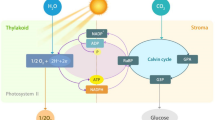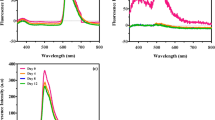Abstract.
Physiological and morphological characteristics related to the CO2-concentrating mechanism (CCM) were examined in several species of the free-living, unicellular volvocalean genus Chloromonas (Chlorophyta), which differs morphologically from the genus Chlamydomonas only by lacking pyrenoids. The absence of pyrenoids in the chloroplasts of Chloromonas (Cr.) rosae UTEX 1337, Cr. serbinowii UTEX 492, Cr.␣clatharata UTEX 1970, Cr. rosae SAG 26.90, and Cr. palmelloides SAG 32.86 was confirmed by light and electron microscopy. In addition, immunogold electron microscopy demonstrated that ribulose-1,5-bisphosphate carboxylase/oxygenase (Rubisco; EC 4.1.1.39) molecules were distributed almost evenly throughout the chloroplasts in all five Chloromonas strains. However, Chloromonas exhibited two types of physiological characteristics related to the CCM depending on the species or strains examined. Chloromonas rosae UTEX 1337 and Cr. serbinowii had high photosynthetic affinities for CO2 in cells grown in culture medium bubbled with air (low-CO2 cells), compared with those grown in medium bubbled with 5% CO2 (high-CO2 cells), indicating the presence of the low-CO2-inducible CCM. In addition, these two Chloromonas strains exhibited low-CO2-inducible carbonic anhydrase (CA; EC 4.2.1.1) activity and seemed to have small intracellular inorganic carbon pools. Therefore, it appears that Cr. rosae UTEX 1337 and Cr. serbinowii possess the CCM as in pyrenoid-containing microalgae such as Chlamydomonas reinhardtii. By contrast, Cr. clatharata, Cr. rosae SAG 26.90 and Cr. palmelloides showed low photosynthetic affinities for CO2 when grown under both CO2 conditions. Moreover, these three strains exhibited an apparent absence of intracellular inorganic carbon pools and lacked low-CO2-inducible CA activity. Thus, Cr. clatharata, Cr. rosae SAG 26.90 and Cr. palmelloides, like other pyrenoid-less algae (lichen photobionts) reported previously, seem to lack the CCM. The present study is the first demonstration of the CCM in pyrenoid-less algae, indicating that pyrenoids or accumulation of Rubisco in the chloroplasts are not always essential for the CCM in algae. Focusing on this type of CCM in pyrenoid-less algae, the physiological and evolutionary significance of pyrenoid absence is discussed.
Similar content being viewed by others
Author information
Authors and Affiliations
Additional information
Received: 1 May 1997 / Accepted: 11 September 1997
Rights and permissions
About this article
Cite this article
Morita, E., Abe, T., Tsuzuki, M. et al. Presence of the CO2-concentrating mechanism in some species of the pyrenoid-less free-living algal genus Chloromonas (Volvocales, Chlorophyta). Planta 204, 269–276 (1998). https://doi.org/10.1007/s004250050256
Issue Date:
DOI: https://doi.org/10.1007/s004250050256




